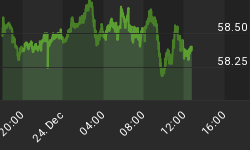Readers of the last 4 articles (since Jan 4) were given several technical and fundamental argumenst calling for more declines in EURUSD. Here's another one, with a touch of gold. Last week, gold hit a new record high in euro terms, highlighting the latest weakness in the single currency rather than gold's improved lustre. Analysing gold's movements against various currencies is not only crucial in weighing the true performance in the precious metal, but also important in valuing a currency's secular movement (rather than comparing it to other currencies). Thus, figuring out whether a falling EURUSD is a result of broadening euro weakness rather than a strengthening USD can be addressed via golds multi-FX analysis.

The first chart shows weekly gold in USD terms suffering from classic bearish case of lower highs i.e. failed rebounds. The $1,125 record high from December 2nd coincided with the same month of the higher than expected US November jobs report and the triple downgrade of Greece credit rating from Fitch, Moodys and S&P. As long as gold fails to regain $1,133 (50% retracement of the decline from 1225 high to 1043 low), it remains vulnerable to $1,020 (target by Mar 6th), followed by $980. Our long-term bullish stance in gold would only be reconsidered in the event of a break below $880.
The second chart shows weekly gold in EUR terms reaching a new record high of EUR 831.00 Since this occurrence is primarily EUR-driven move, it merits more attention regarding its implications for EUR rather than gold. We would only start to focus on golds strengthening trend when it nears its highs vs. the stronger JPY and AUD as was the case in early December.
The third chart shows eroding interest in gold net longs (positioning of futures contracts in NY Mercantile Exchange). Last week, net longs rose for the first time in 5 weeks after having fallen to 181,519 contracts, the lowest since September. Since December, falling net longs were more a case of a decline in new longs rather than an escalation in fresh shorts, which is unlike in Q3 2008, when golds decline was prompted by surging shorts as a result of the great unwinding trade. Reconciling golds robust performance against EUR and the fading interest in gold net longs (vs. USD) justifies our bearishness in EURUSD as well as anticipation of further losses in Gold/USD. Technical analysis of golds net longs suggests the decline will retest the 130K level from the current 188K.
Fed Chairman Bernanke will likely use this weeks semiannual monetary policy testimony to tone down any overshoot in short term yields by reiterating exceptionally low levels of the federal funds rate for an extended period, but that will likely fail in dissuading USD bulls, especially as bond traders anticipate payment of interest on reserves as the Feds next step of exiting its liquidity strategy.
3-year Anniversary of the Pre-Crash Correction February 27 (marks the 3-year anniversary of the 1st correction in global bourses, which wiped out nearly $600 billion in market value, triggered by fears of higher transaction taxes in China, an expected plunge in US durable orders and preliminary fears of US subprime debt. The Shanghai Composite plunged 10%, NASDAQ fell 4% and DJIA dropped 3%. While the global patient has shown marked signs of improvement, it remains highly vulnerable to multiple sources of contagion (Eurozone fiscal woes, Chinese tightening, rating concerns in Gulf & pace of liquidity reduction by Fed). Pay attention to recurring cycles and repeat events.
Canadian dollar falls across the board as markets unwind gains in commodity currencies ahead of potential event-risk from Bernanke's testimony. CADJPY bearishness was highlighted by negative crossover in the stochastics, losing 270 pips since Monday's tweets and IMTs. Subscribers to our IMTs and Twitter.com/alaidi were initially warned on ensuing CADJPY bearishness on Monday when it stood at 87.70.
For a more detailed analsyis on valuing gold in various currencies, see Chapters 1 and 8 of my book "Currency Trading & Intermarket Analysis". and IMTs.
Subscribe FREE to our Intraday Market Thoughts (IMTs) and follow us on Twitter for breaking trading analysis.
















